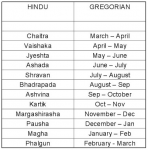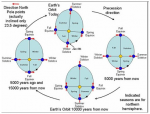Enigmatic Light
Member
- Joined
- Apr 30, 2019
- Messages
- 65
- Reaction score
- 2
- Points
- 8
The calendar that we follow today is the Gregorian calendar, which was introduced in 1582. This was after it was found that the calendar in use till then, the Julius version, accounted for 365.25 days in a year, when in effect it was 365 days, 5 hours, 48 minutes and 46 seconds, thus slightly lesser than the assumed value. As a result, the equinox was moving steadily ahead in the year, and this was considered unacceptable.
As you know, in the current system, we have a leap year once every 4 years to compensate for the extra fraction of time taken by our beloved earth to revolve around the sun. In school, the unlucky individual whose birthday fell on 29th February was always urged to change his date of birth in order that he celebrate it ! The leap year problem is also an essential part of any quantitative aptitude test to ascertain the time period elapsed, etc.
Now, as the Gregorian calendar adds 1 day at the end of 4 years, it is not moving in synchronism with the sun. Spare the electrical jargon, but this is like a fixed step size, and does not vary smoothly taking into account the sun's variation.
Comparing the Gregorian along with the Hindu calendar, which is generally referred to as the Panchang, we see that the Hindu version has a much more scientific relationship. While the former is based on the Solar variation and accounts for the earth's revolution around the sun as 12 months each having 30 days, the latter is based on the moon's revolution around the earth, where each month takes 28 days. To compensate for the loss of days, and extra month, called the Adhik Mas (mas is the word for month), is added every 30 months.
The Hindu counting of years generally concurs with the reign of a prominent king. For instance, the current year is the Vikram Samvat 2067, signifying that King Vikramaditya's reign started as many years ago (in 57 BC). There are many such Samvats known, but the Vikram Samvat is what is the most widely accepted and in use currently. The various months in the Vikram Samvat are listed below along with their approximate Gregorian Calendar counterparts:

Each of these months in the Hindu calendar (with 28 days) is subdivided into 2 cycles of moon waxing and waning. The 1st half is called the Krishna Paksha (dark period), where the moon wanes till Amavasya (new moon), and the Shukla Paksha (bright period), where the moon waxes till Purnima (full moon). This can be understood from the below image:

The Hindu calendar in use is a combination of both solar and lunar inferences. The months are based on the moon, while the seasons are governed by the sun. A prominent example of a solar festival is that January 13-14 is celebrated as Pongal (in Tamil Nadu), Sankranti (north India) and Lohri (Punjab). All of these herald the entry of the sun into the Makar rashi, or the northward movement of the sun. Though the date is supposed to be somewhere between December 20th and 23rd, due to earth's tilt, it has kept sliding over years. Don't be surprised if in your future births, you find that Makar Sankranti is being celebrated in May, but that will take 1000s of years to come.

In fact, in certain temples, it is seen that on Sankranti day, sunlight graces the presiding deity. One of the temples that I can remember is the Sri Gavi Gangadhareshwara Temple in Bangalore, where the sunlight falls on the Shiva Lingam through Nandi's horns. Trust the ancients to establish the exact angle to honour God on the auspicious day !
Coming back to tithis, the days are calculated based on the actual longitudinal angular difference between the respective positions of the moon and the sun. Thus, it is very common to see that tithis vary in length, some may be shorter than regular 24 hours, some extending beyond, and this leads to certain auspicious days being celebrated across two days of Gregorian Calendar.
The Zodiac Signs or Rashis are another integral aspect of the Calendar, with 27 Nakshatras (Constellations) forming 12 Rashis, each of the latter accounting for 2.25 of the former. This is the basis of Indian Hindu Astrology, which again is a scientific art, and is very different from the general characterizations governing the Western Zodiac Date-of-birth based astrology.
Via: Nikhil Mundra
As you know, in the current system, we have a leap year once every 4 years to compensate for the extra fraction of time taken by our beloved earth to revolve around the sun. In school, the unlucky individual whose birthday fell on 29th February was always urged to change his date of birth in order that he celebrate it ! The leap year problem is also an essential part of any quantitative aptitude test to ascertain the time period elapsed, etc.
Now, as the Gregorian calendar adds 1 day at the end of 4 years, it is not moving in synchronism with the sun. Spare the electrical jargon, but this is like a fixed step size, and does not vary smoothly taking into account the sun's variation.
Comparing the Gregorian along with the Hindu calendar, which is generally referred to as the Panchang, we see that the Hindu version has a much more scientific relationship. While the former is based on the Solar variation and accounts for the earth's revolution around the sun as 12 months each having 30 days, the latter is based on the moon's revolution around the earth, where each month takes 28 days. To compensate for the loss of days, and extra month, called the Adhik Mas (mas is the word for month), is added every 30 months.
The Hindu counting of years generally concurs with the reign of a prominent king. For instance, the current year is the Vikram Samvat 2067, signifying that King Vikramaditya's reign started as many years ago (in 57 BC). There are many such Samvats known, but the Vikram Samvat is what is the most widely accepted and in use currently. The various months in the Vikram Samvat are listed below along with their approximate Gregorian Calendar counterparts:

Each of these months in the Hindu calendar (with 28 days) is subdivided into 2 cycles of moon waxing and waning. The 1st half is called the Krishna Paksha (dark period), where the moon wanes till Amavasya (new moon), and the Shukla Paksha (bright period), where the moon waxes till Purnima (full moon). This can be understood from the below image:

The Hindu calendar in use is a combination of both solar and lunar inferences. The months are based on the moon, while the seasons are governed by the sun. A prominent example of a solar festival is that January 13-14 is celebrated as Pongal (in Tamil Nadu), Sankranti (north India) and Lohri (Punjab). All of these herald the entry of the sun into the Makar rashi, or the northward movement of the sun. Though the date is supposed to be somewhere between December 20th and 23rd, due to earth's tilt, it has kept sliding over years. Don't be surprised if in your future births, you find that Makar Sankranti is being celebrated in May, but that will take 1000s of years to come.

In fact, in certain temples, it is seen that on Sankranti day, sunlight graces the presiding deity. One of the temples that I can remember is the Sri Gavi Gangadhareshwara Temple in Bangalore, where the sunlight falls on the Shiva Lingam through Nandi's horns. Trust the ancients to establish the exact angle to honour God on the auspicious day !
Coming back to tithis, the days are calculated based on the actual longitudinal angular difference between the respective positions of the moon and the sun. Thus, it is very common to see that tithis vary in length, some may be shorter than regular 24 hours, some extending beyond, and this leads to certain auspicious days being celebrated across two days of Gregorian Calendar.
The Zodiac Signs or Rashis are another integral aspect of the Calendar, with 27 Nakshatras (Constellations) forming 12 Rashis, each of the latter accounting for 2.25 of the former. This is the basis of Indian Hindu Astrology, which again is a scientific art, and is very different from the general characterizations governing the Western Zodiac Date-of-birth based astrology.
Via: Nikhil Mundra
